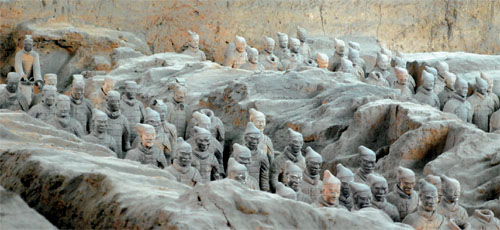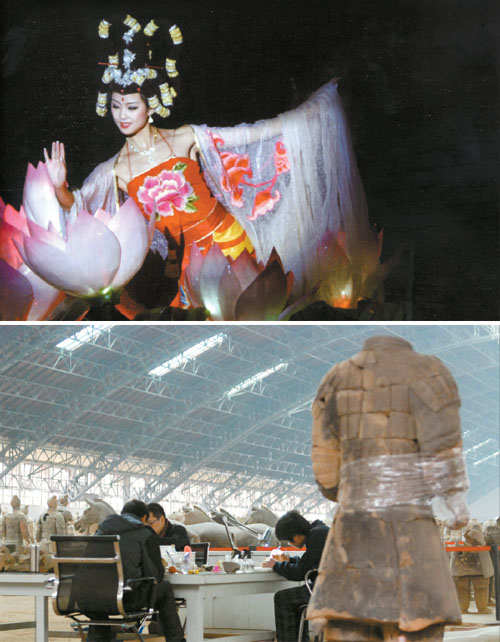Terra-cotta army still stands guard

Terra-cotta warriors stand in formation at Emperor Qin Shi Huang’s mausoleum in Xian, China. By Christine Kim
XIAN, Shaanxi Province - In the spring of 1974, five farmers digging a well in eastern Xian, Shaanxi Province, made one of the most important archeological discoveries of the 20th century. Instead of finding a source of water, they unearthed something that would forever change their lives, revealing a gold mine of ancient artifacts that allowed scholars to rewrite the history of the first emperor of unified China.
China had long forgotten about the army of terra-cotta warriors, which were originally built on the orders of Emperor Qin Shi Huang (259 BC?210 BC). Historians estimate the army survived buried beneath the ground from about 209 BC.
When he was just 13-years-old, Qin Shi Huang ordered the construction of his mausoleum and thousands of stone warriors to guard it after his death. It is estimated that the emperor ordered 64 workers to create the warriors’ faces, none of which are exactly the same.
According to regional experts, signatures of the artists could be found on the warriors, which are 170 to 200 centimeters (5 feet 7 inches to 6 feet 7 inches) in height. The warriors had originally been finished with color lacquer, but the Chinese workers at the mausoleum explained that the varnish had long disintegrated.
The mausoleum’s main tomb containing the emperor has yet to be opened.

Top: A performer dances during a performance of “The Song of Everlasting Sorrow.” Provided by the performance organizer / Above: Workers piece together fragments of terra-cotta warriors. By Christine Kim
Roughly 8,000 stone warriors were buried in the mausoleum, along with hundreds of terra-cotta horses and over 100 chariots. The warriors’ appearance and attire vary by rank. They can be largely divided into classes: generals, middle-ranking officers, lower-ranking officers, ordinary soldiers and resistant warriors. There have only been seven generals found in the pit.
Only part of the mausoleum is open to the public, where row upon row of the terra-cotta soldiers stand at attention. There are three large pits. The largest, pit No. 1, has the most warriors and draws the highest number of sightseers.
When walking around the mausoleum, visitors are frequently stopped by local men with bulging backpacks that hawk little gift boxes with miniature soldiers. The pricing depends on the buyer’s ability to haggle, which is expected at nearly all vendors here.
One of the original five farmers sometimes makes an appearance at the official gift shop. Locals say the government had to teach the man how to write his name so he could sign autographs.
The terra-cotta army is undoubtedly the most important tourist site in the vicinity of Xian, but there are other intriguing stops here.
The Huaqing Hot Springs - once the site of a famous love affair between Emperor Xuanzong (685-762) and his concubine Yang Guifei in the Tang Dynasty (618-907) - attract many visitors. It is situated on the northern foot of Mount Lishan in Lintong County, 30 kilometers from Xian.
Visitors today can see where royals once bathed. The sprawling Huaqing Palace was built around the hot springs by King You during the Western Zhou Dynasty (11th century BC) and has been subsequently expanded on a number of times, most notably by Emperor Xuanzong (685-762) of the Tang dynasty.

Ladles from the Western Zhou Dynasty (11th century BC) are on display at Shaanxi History Museum. By Christine Kim
The performance tells of the romance between Emperor Xuanzong and his concubine.
Although the emperor is said to have had tens of thousands of beautiful women live inside his palaces, Yang Yuhuan was his favorite during the later years of his reign. After he made Yang his consort, she was given permission to use Huaqing Pool at the hot springs, which had until then been reserved for royal use only. A small pagoda still exists where Yang used to dry her hair, tour guides say. Some locals claimed that Yang’s habit of taking frequent baths was to mask her body odor.
As the emperor carried on with Yang, he was put in a tough spot when her brother was accused of plotting a revolution. It was then demanded of Emperor Xuanzong that he put his lover to death. He first refused, then relented.
The emperor ordered that she be strangled to death, but locals say she committed suicide before palace authorities could get their hands on her.
The Song of Everlasting Sorrow is conducted in nine parts, during which elaborate costumes and dance can be seen on a stage that at times is submerged underwater for dramatic effect.
Adding to the spectacle, the entire face of Mount Lishan is lit up during the performance with LED lights to mimic stars, and a giant artificial moon glows in the distance - the appearance of which draws “oos” and “ahs” from the audience.
The performance season begins in April.
If visitors fail to make it to the hot springs or The Song of Everlasting Sorrow is canceled due to rain, the Shaanxi History Museum is worth a visit.
It tells the history of Xian from tens of thousands of years ago to the creation of the terra-cotta warriors. The 65,000 square meter (699,654 square feet) museum, which opened its doors in 1991, houses over 370,000 artifacts.
By Christine Kim [christine.kim@joongang.co.kr]
한글 관련 기사 [연합]
진시황 사자의 정방폭포 절벽 마애 사실일까
제주도, ‘徐市過之’ 글귀 정밀조사 계획
기원전 중국 진시황(秦始皇)의 명을 받고 제주에 불로초를 캐러왔던 서복(徐福)이 서귀포시 정방폭포 절벽에 글귀를 새겨넣었다는 전설이 사실일까?
제주도는 서복 또는 서불(徐市. 市는 슬갑 불)로 불리는 진시황의 사자가 정방폭포 절벽에 `徐市過之`(서불과지:서불이 이곳을 지나갔다는 뜻)란 글귀를 새겼다는 전설의 사실 여부를 확인하기 위해 정밀조사를 벌일 계획이라고 6일 밝혔다.
도는 올해 하반기에 전문용역기관에 맡겨 높이가 23m, 너비 10여m인 정방폭포의 절벽을 대상으로 3D 영상카메라 등 첨단장비를 동원해 마애가 존재하는지를 확인할 방침이다.
절벽의 암석 일부가 떨어져 나왔을 가능성도 있다고 보고 폭포 아래에 있는 낙석도 조사한다. 3D 영상카메라는 0.1㎜의 작은 음영도 확인할 수 있다.
지난 1993년 암벽 등산 전문가들이 절벽을 타고 마애 존재 여부를 조사했으나 확인하지 못했다.
도는 정밀조사에 앞서 문헌자료 조사와 정방폭포 주변 현장답사를 진행하며, 1993년 시행한 조사에 참가한 사람들의 증언도 들어 참고할 예정이다.
정방폭포에는 진시황(BC 259∼BC 210) 때 제주에서 불로초를 캐러 돌아다니던 서복이 폭포 주변 절경에 감탄, 절벽에다 글귀를 새겨넣었다고 전해진다.
지난 2008년 명승 제43호로 지정된 정방폭포는 동양에서 유일하게 바다로 떨어지는 2줄기 폭포로 주변 경관이 뛰어나 국내외 관광객들이 즐겨 찾는 관광명소다.
서귀포시는 지난 2003년 10월 정방폭포 인근에 서복전시관을 조성, 개관했다. 전시관에는 서복이 수천명의 어린 남녀 등 일행이 타고 왔다는 선박의 축소 모형, 서복과 진시황에 얽힌 이야기를 재현한 애니메이션, 벽화, 병마용갱 복제품 등이 전시돼 있다.
제주도 이규봉 문화정책과장은 "이번에는 육안조사가 아니라 첨단 장비를 이용한 정밀조사이기 때문에 마애가 존재한다면 확인할 수 있을 것"이라며 "만일 사실로 드러난다면 훌륭한 관광자원이 될 것으로 본다"고 말했다.










with the Korea JoongAng Daily
To write comments, please log in to one of the accounts.
Standards Board Policy (0/250자)